
Longships were a type of specialised Scandinavian warships that have a long history in Scandinavia, with their existence being archaeologically proven and documented from at least the fourth century BC. Originally invented and used by the Norsemen for commerce, exploration, and warfare during the Viking Age, many of the longship's characteristics were adopted by other cultures, like Anglo-Saxons, and continued to influence shipbuilding for centuries. The longship's design evolved over many centuries, and continuing up until the 6th century with clinker-built ships like Nydam and Kvalsund. The longship appeared in its complete form between the 9th and 13th centuries. The character and appearance of these ships have been reflected in Scandinavian boat-building traditions until today. The particular skills and methods employed in making longships are still used worldwide, often with modern adaptations. They were all made out of wood, with cloth sails and had numerous details and carvings on the hull.

A sailing ship is a sea-going vessel that uses sails mounted on masts to harness the power of wind and propel the vessel. There is a variety of sail plans that propel sailing ships, employing square-rigged or fore-and-aft sails. Some ships carry square sails on each mast—the brig and full-rigged ship, said to be "ship-rigged" when there are three or more masts. Others carry only fore-and-aft sails on each mast—schooners. Still others employ a combination of square and fore-and aft sails, including the barque, barquentine, and brigantine.

A dinghy is a type of small boat, often carried or towed by a larger vessel for use as a lifeboat or tender. Utility dinghies are usually rowboats or have an outboard motor. Some are rigged for sailing but they differ from sailing dinghies, which are designed first and foremost for sailing. A dinghy's main use is for transfers from larger boats, especially when the larger boat cannot dock at a suitably-sized port or marina.

A Yawl is a type of boat. The term has several meanings. It can apply to the rig, to the hull type or to the use which the vessel is put.

A junk is a type of Chinese sailing ship with fully battened sails. There are two types of junk in China: Northern junk, which is developed from Chinese river boats, and southern junk which is developed from Austronesian ship designs, examples of which have been trading with the Eastern Han dynasty since the 2nd century AD. They continued to evolve in the later dynasties, and were predominantly used by Chinese traders throughout Southeast Asia. They were found, and in lesser numbers are still found, throughout Southeast Asia and India, but primarily in China. Found more broadly today is a growing number of modern recreational junk-rigged sailboats. Chinese junks referred to many types of coastal or river ships. They were usually cargo ships, pleasure boats, or houseboats. Historically they have ranged in size from small river and coastal vessels to large ocean going ships, and there are significant regional variations in the type of rig, however they all employ fully battened sails.

A rudder is a primary control surface used to steer a ship, boat, submarine, hovercraft, aircraft, or other conveyance that moves through a fluid medium. On an aircraft the rudder is used primarily to counter adverse yaw and p-factor and is not the primary control used to turn the airplane. A rudder operates by redirecting the fluid past the hull (watercraft) or fuselage, thus imparting a turning or yawing motion to the craft. In basic form, a rudder is a flat plane or sheet of material attached with hinges to the craft's stern, tail, or after end. Often rudders are shaped so as to minimize hydrodynamic or aerodynamic drag. On simple watercraft, a tiller—essentially, a stick or pole acting as a lever arm—may be attached to the top of the rudder to allow it to be turned by a helmsman. In larger vessels, cables, pushrods, or hydraulics may be used to link rudders to steering wheels. In typical aircraft, the rudder is operated by pedals via mechanical linkages or hydraulics.

A cog is a type of ship that first appeared in the 10th century, and was widely used from around the 12th century on. Cogs were clinker-built, generally of oak. These vessels were fitted with a single mast and a square-rigged single sail. They were mostly associated with seagoing trade in north-west medieval Europe, especially the Hanseatic League. Typical seagoing cogs ranged from about 15 to 25 meters in length, with a beam of 5 to 8 meters and were 30–200 tons burthen. Cogs were rarely as large as 300 tons although a few were considerably larger, over 1,000 tons.
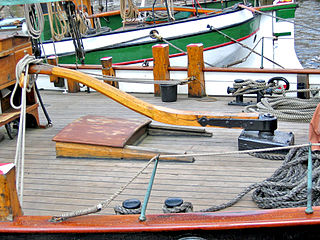
A tiller or till is a lever used to steer a vehicle. The mechanism is primarily used in watercraft, where it is attached to an outboard motor, rudder post or stock to provide leverage in the form of torque for the helmsman to turn the rudder. A tiller may also be used in vehicles outside of water, and was seen in early automobiles.
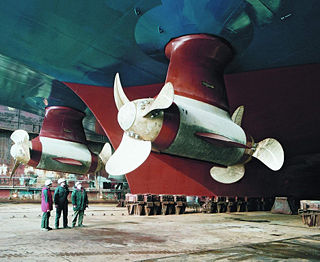
An azimuth thruster is a configuration of marine propellers placed in pods that can be rotated to any horizontal angle (azimuth), making a rudder unnecessary. These give ships better maneuverability than a fixed propeller and rudder system.
This is a partial glossary of nautical terms; some remain current, while many date from the 17th to 19th centuries. See also Wiktionary's nautical terms, Category:Nautical terms, and Nautical metaphors in English. See the Further reading section for additional words and references.

A ship's wheel or boat's wheel is a device used aboard a water vessel to steer that vessel and control its course. Together with the rest of the steering mechanism, it forms part of the helm. It is connected to a mechanical, electric servo, or hydraulic system which alters the vertical angle of the vessel's rudder relative to its hull. In some modern ships the wheel is replaced with a simple toggle that remotely controls an electro-mechanical or electro-hydraulic drive for the rudder, with a rudder position indicator presenting feedback to the helmsman.

A helmsman or helm is a person who steers a ship, sailboat, submarine, other type of maritime vessel, or spacecraft. The rank and seniority of the helmsman may vary: on small vessels such as fishing vessels and yachts, the functions of the helmsman are combined with that of the skipper; on larger vessels, there is a separate officer of the watch who is responsible for the safe navigation of the ship and gives orders to the helmsman, who physically steers the ship in accordance with those orders.
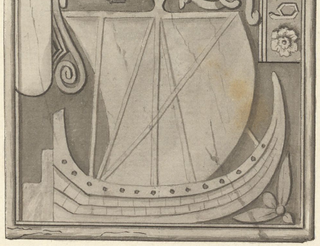
The birlinn was a wooden vessel propelled by sail and oar, used extensively in the Hebrides and West Highlands of Scotland from the Middle Ages on. Variants of the name in English and Lowland Scots include "berlin" and "birling". The Gallo-Norse term may derive from the Norse byrðingr. It has been suggested that a local design lineage might also be traceable to vessels similar to the Broighter-type boat, equipped with oars and a square sail, without the need to assume a specific Viking design influence. It is uncertain, however, whether the Broighter model represents a wooden vessel or a skin-covered boat of the currach type. The majority of scholars emphasise the Viking influence on the birlinn.
Self-steering gear is equipment used on sail boats to maintain a chosen course or point of sail without constant human action.
The ships of Medieval Europe were powered by sail or oar, or both. There was a large variety, mostly based on much older conservative designs. Although wider and more frequent communications within Europe meant exposure to a variety of improvements, experimental failures were costly and rarely attempted. Ships in the north were influenced by Viking vessels, while those in the south by classical or Roman vessels. However, there was technological change. The different traditions used different construction methods; clinker in the north, carvel in the south. By the end of the period, carvel construction would come to dominate the building of large ships. The period would also see a shift from the steering oar or side rudder to the stern rudder and the development from single to multi-masted ships. As the area is connected by water, it would make sense that people in the Mediterranean would build different kinds of ships to accommodate different sea levels and climate. Within the Mediterranean area during the Medieval times ships were used for a multitude of reasons, like war, trade, and exploration.
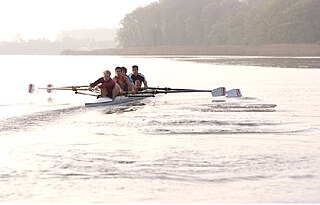
A coxless four is a rowing boat used in the sport of competitive rowing. It is designed for four persons who propel the boat with sweep oars.

Port and starboard are nautical terms of orientation that deal unambiguously with the structure of vessels, referring respectively to the left and right sides of the vessel, seen by an observer aboard the vessel looking forward.
The Irish galley was a vessel in use in the West of Ireland down to the seventeenth century, and was propelled both by oars and sail. In fundamental respects it resembled the Scottish galley or bìrlinn, their mutual ancestor being the Viking longship. Both the Irish and Scottish versions were colloquially known as "longa fada" (longships). The Irish galley was commonly an eight or twelve-oared vessel and was used for both warfare and trade. It was notable for its speed when rowed.
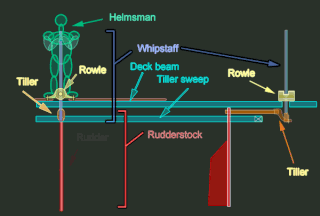
A whipstaff, sometimes called a whip, is a steering device that was used on 16th- and 17th-century European sailing ships. Its development preceded the invention of the more complex ship's wheel and followed the simple use of a tiller to control the steering of a ship underway.

Garay were traditional native warships of the Banguingui people in the Philippines. In the 18th and 19th centuries, they were commonly used for piracy by the Banguingui and Iranun people against unarmed trading ships and raids on coastal settlements in the regions surrounding the Sulu Sea.
















